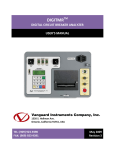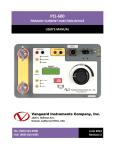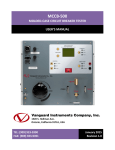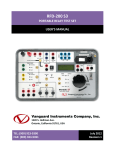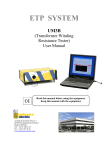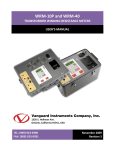Download WRM-10 - Vanguard Instruments Company, Inc.
Transcript
WRM-10TM TRANSFORMER WINDING RESISTANCE METER USER’S MANUAL Vanguard Instruments Company, Inc. 1520 S. Hellman Ave. Ontario, California 91761, USA TEL: (909) 923-9390 FAX: (909) 923-9391 June 2009 Revision 2 WRM-10 USER’S MANUAL REV 2 SAFETY SUMMARY FOLLOW EXACT OPERATING PROCEDURES Any deviation from the procedures described in this User’s Manual may create one or more safety hazards, may damage the WRM-10, damage the test transformer, or cause errors in the test results. Vanguard Instruments Company, Inc. assumes no liability for unsafe or improper use of the WRM-10. All safety precautions provided in this manual must be observed during all phases of testing including test preparation, test lead connection, actual testing, and test lead disconnection. SAFETY WARNING AND CAUTIONS The WRM-10 shall be used only by trained operators. All transformers under test shall be offline and fully isolated. DO NOT MODIFY TEST EQUIPMENT To avoid the risk of introducing additional or unknown hazards, do not install substitute parts or perform any unauthorized modification to any WRM-10 test unit. To ensure that all designed safety features are maintained, it is highly recommended that repairs be performed only by Vanguard Instruments Company factory personnel or by an authorized repair service provider. Unauthorized modifications can cause safety hazards and will void the manufacturer’s warranty. WARNING Do not remove test leads during a test. Failure to heed this warning can result in lethal electrical shock to personnel and damage to the equipment. i REV 2 WRM-10 USER’S MANUAL TABLE OF CONTENTS CONVENTIONS USED IN THIS DOCUMENT ..................................................................................... 1 1.0 INTRODUCTION .................................................................................................................... 2 1.1 General Description and Features ................................................................................... 2 1.3 Technical Specifications ................................................................................................... 3 1.4 WRM-10 Controls and Indicators .................................................................................... 4 2.0 PRE-TEST SETUP ................................................................................................................... 6 2.1 Operating Voltages .......................................................................................................... 6 3.0 OPERATING PROCEDURES ................................................................................................... 9 3.1 WRM-10 Cable Connections ............................................................................................ 9 3.2 General Procedures ....................................................................................................... 11 3.3 Performing Transformer Tests ....................................................................................... 12 3.3.1. Performing a Single Resistance Test ...................................................................... 12 3.3.2. Performing a Voltage Regulator Test ..................................................................... 14 3.4 User Diagnostic Mode .................................................................................................... 16 LIST OF FIGURES Figure 1. WRM-10 Controls and Indicators .................................................................................... 4 Figure 2. 100 – 120 Vac Jumper Settings ........................................................................................ 6 Figure 3. 200 – 240 Vac Jumper Settings ........................................................................................ 6 Figure 4. Relay Location .................................................................................................................. 7 Figure 5. Typical WRM-10 Connections Diagram #1 ...................................................................... 9 Figure 6. Typical WRM-10 Connections Diagram #2 .................................................................... 10 Figure 7. Typical Dual Winding Connections Diagram .................................................................. 10 LIST OF TABLES Table 1. WRM-10 Technical Specifications ..................................................................................... 3 Table 2. Functional Descriptions of WRM-10 Controls and Indicators .......................................... 5 Table 3. Voltage Selection Jumper Settings .................................................................................... 6 ii WRM-10 USER’S MANUAL REV 2 CONVENTIONS USED IN THIS DOCUMENT This document uses the following conventions: • The WRM-10’s control knob is referenced as [CONTROL KNOB] • Menu names are referenced as “MENU NAME” • WRM-10 LCD screen output is shown as: MAIN MENU <RUN TEST> • Warning messages are indicated as: Warning message WARNING • Important notes are indicated as: Note details NOTE 1 REV 2 WRM-10 USER’S MANUAL 1.0 INTRODUCTION 1.1 General Description and Features The WRM-10 is designed to accurately measure the winding resistance of highly inductive power transformers. The unit’s dual resistance-reading input channels can measure two winding resistances simultaneously. Four-wire (Kelvin) connections provide high accuracy voltage reading and require no lead compensation. The WRM-10 provides stable resistance readings of very large transformers by utilizing a 36 Vdc power supply capable of outputting up to 10 Amperes. The resistance reading of a 100MVA transformer can be achieved in 5 minutes or less. The unit’s power supply is cooled by heavy-duty fans designed for continuous operation. Since the WRM-10 can accurately measure resistances ranging from 1 micro-ohm to 2,000 ohms, it can also be used to measure EHV circuit-breaker contact resistance, motor winding resistance, or any low resistance. In addition to measuring the resistance value, the WRM-10 also checks the “make-before-break” tap-switching sequences of voltage regulators and load tap changers. The WRM-10 is furnished with three 50-foot test cables, a ground cable, a power cord, and a cable carrying bag. Each test cable lead is terminated with a quick-disconnect test clip. 1.2 Functional Description The WRM-10’s operation is based on the electrical relationship described by Ohm’s law: R=V/I, where I is a known current and V is the DC voltage measured across the unknown resistance. The value of the unknown resistance is calculated by dividing the measured voltage by the current which is calculated by the microprocessor. Calculated resistance readings are then displayed on the unit’s back-lit LCD screen. A special current source allows the WRM-10 to output up to 10 Amperes of test current. The test current is automatically adjusted depending on the load resistance. For added safety, the current source circuit is thermally protected. Also, a built-in discharge circuit automatically discharges the stored energy in the transformer at the end of each test. 2 WRM-10 USER’S MANUAL 1.3 REV 2 Technical Specifications Table 1. WRM-10 Technical Specifications TYPE Portable transformer winding resistance meter PHYSICAL SPECIFICATIONS 16.8”W x 12.6”H x 10.6”D (42.6 cm x 32.0 cm x 27 cm); Weight: 27 lbs (12.2 kg) INPUT POWER 100 – 120 Vac or 200-240 Vac (factory pre-set), 50/60 Hz RESISTANCE READING 1 micro-ohm – 2,000 ohms RANGE ACCURACY 1 – 19,999 micro-ohms: ±0.5% reading, ±1 count 20 – 999 milli-ohms: ±1% reading, ±1 count; 1 – 2,000 ohms: ±1.5% reading, ±1 count TEST VOLTAGE 36 Vdc max TEST CURRENT RANGE Auto range, 10 Amperes max DISPLAY CONTROL COMPUTER INTERFACE Back-lit LCD Screen (16 characters by 2 lines); viewable in bright sunlight and low-light levels Single “turn-and-push” knob RS-232C port (19,200 baud) used for factory calibration and diagnostics SAFETY Designed to meet IEC61010 (1995), UL61010A-1, CSA-C22.2 standards ENVIRONMENT CABLES Operating: -10˚C to 50˚ C (15˚F to +122˚ F); Storage: -30˚ C to 70˚ C (22˚F to +158˚ F) Three 50-foot test cables, ground cable, power cord and cable bag OPTIONS Transportation case WARRANTY One year on parts and labor The above specifications are valid at nominal operating voltage and at a temperature of 25°C (77°F). Specifications may change without prior notice. NOTE 3 REV 2 1.4 WRM-10 USER’S MANUAL WRM-10 Controls and Indicators The WRM-10’s controls and indicators are shown in Figure 1 below. A leader line with an index number points to each control and indicator, which is cross-referenced to a functional description in Table 2. The table describes the function of each item on the control panel. The purpose of the controls and indicators may seem obvious, but users should become familiar with them before using the WRM-10. Accidental misuse of the controls will usually cause no serious harm. Users should also be familiar with the safety summary found on the front page of this User’s Manual. Figure 1. WRM-10 Controls and Indicators 4 WRM-10 USER’S MANUAL REV 2 Table 2. Functional Descriptions of WRM-10 Controls and Indicators Item Number Panel Markings 1 V1 Voltage sensing input channel #1. Female connector jacks used for connecting voltage-sensing test leads. 2 I Current output. Female connector jacks used for connecting current test leads. 3 None Back-lit LCD screen (16 characters by 2 lines); viewable in bright sunlight and low-light levels. 4 GROUND Safety ground terminal. 5/16-18 threaded stud with hand-turned wing nut. This must be connected to the station ground before connecting any WRM-10 test leads to the transformer. 5 100-120 Vac. 2A, 50-60 Hz Fuse: 250 Vac, 3A Slow-Blow Functional Description Input power connector with third-wire safety ground. On/Off rocker toggle switch with built-in fuse protection. 9-pin RS-232C interface port; female DB type. Data rate is set to 19,200 baud, 1 start bit, 2 stop bits, 8 data bits and no parity bit. Pin Signal 6 RS-232C 2 RX 3 TX 5 Signal Ground 7 DISCHARGE Red LED indicator light. This warning indicator is lit when the WRM-10 is discharging the stored energy in the transformer. Do NOT disconnect the test leads when this light is on. Failure to heed this warning can result in shock and/or fatal injury to personnel. 8 CHANGE “PUSH” TO SELECT Single turn-and-press control knob used to operate the WRM-10. You can scroll through different menu options by turning this knob, and you can select a function by pressing the knob. 9 HIGH VOLTAGE PRESENT 10 V2 Red LED indicator light. This warning light is illuminated when there is a possibility of high voltage across the test leads. Do NOT disconnect the test leads when this light is on. Failure to heed this warning can result in shock and/or fatal injury to personnel. Voltage input sensing channel #2. Female connector jacks used for connecting voltage-sensing test leads. 5 REV 2 WRM-10 USER’S MANUAL 2.0 PRE-TEST SETUP 2.1 Operating Voltages The WRM-10’s operating voltage is preset at the factory and is selectable between 100-120 Vac, 50/60 Hz or 200-240 Vac, 50/60 Hz. The voltage is set by placing jumper(s) on the power terminal block as listed in Table 3 and illustrated in Figure 2 and Figure 3. The relay must also be changed if the voltage settings are changed. Please see Figure 4 for the location of the relay. Table 3. Voltage Selection Jumper Settings Voltage Selection Terminal Block Jumpers Relay Part Number 100 – 120 Vac Brown to Blue and Yellow to Green HE2aN-Q-AC120V 200 – 240 Vac Blue to Yellow HE2aN-Q-AC-240V Figure 2. 100 – 120 Vac Jumper Settings Figure 3. 200 – 240 Vac Jumper Settings 6 WRM-10 USER’S MANUAL REV 2 Figure 4. Relay Location 7 REV 2 2.2 WRM-10 USER’S MANUAL LCD Screen Contrast Control To adjust the LCD screen’s contrast: a. Start from the “MAIN MENU”: MAIN MENU <RUN TEST> Turn the [CONTROL KNOB] till the following screen is displayed: MAIN MENU <ADJ CONTRAST> Press the [CONTROL KNOB]. b. The following screen will be displayed: ADJ CONTRAST “PUSH” = DONE Turn the [CONTROL KNOB] clockwise to increase the contrast (darken the screen). Turn the [CONTROL KNOB] counter-clockwise to decrease the contrast (lighten the screen). Press the [CONTROL KNOB] when you are done adjusting the contrast level. You will be returned to the “MAIN MENU”. 8 WRM-10 USER’S MANUAL 3.0 OPERATING PROCEDURES 3.1 WRM-10 Cable Connections REV 2 Typical WRM-10 connections diagrams are shown in Figure 5 and Figure 6. A typical dual winding connections diagram is shown in Figure 7. WARNING Do not touch or disconnect any test lead that is connected to a transformer terminal while high current is being conducted during a test. Failure to heed this warning can result in lethal electric shock to personnel and/or damage to the equipment. Figure 5. Typical WRM-10 Connections Diagram #1 WARNING Disconnect the test clips from the transformer bushing only after the WRM-10 has completely discharged the transformer. Always disconnect the test clips slowly from the transformer bushing to prevent an accidental flash-over. 9 REV 2 WRM-10 USER’S MANUAL Figure 6. Typical WRM-10 Connections Diagram #2 NOTE The above figure illustrates the simultaneous testing of both the high and low windings on a single-phase transformer. When measuring two channels, the above cable connection is recommended since it will speed up the testing process. Figure 7. Typical Dual Winding Connections Diagram 10 WRM-10 USER’S MANUAL 3.2 REV 2 General Procedures The main steps for using the WRM-10 are outlined below: a. Ground the WRM-10 to the substation ground. WARNING Always connect the WRM-10 to the substation ground before connecting any test lead to any transformer bushing. Failure to follow this procedure may damage the WRM-10. b. Plug the WRM-10 power cable into a power outlet. c. Insert current-cable plugs and voltage-sensing cable plugs into the corresponding control panel jacks. d. Attach the test cable clamps to the transformer terminal for the winding that is to be measured. e. Turn on the WRM-10 by pressing [I] on the power rocker switch. f. The unit will self-calibrate, and then you will be presented with the “MAIN MENU” as shown below: MAIN MENU <RUN TEST> 11 REV 2 3.3 WRM-10 USER’S MANUAL Performing Transformer Tests 3.3.1. Performing a Single Resistance Test a. Start from the “MAIN MENU”: MAIN MENU <RUN TEST> Press the [CONTROL KNOB]. b. The following screen will be displayed: RUN TEST <V1 & V2> Turn the [CONTROL KNOB] till the following screen is displayed: RUN TEST <V1 ONLY> Press the [CONTROL KNOB]. c. The following screen will be displayed: FLASH-OVER IF CABLES REMOVED! Press the [CONTROL KNOB]. d. The following screen will be displayed: “PRESS” TO START “TURN” TO ABORT Press the [CONTROL KNOB] to start the test. You can abort the test by turning the [CONTROL KNOB]. e. The following screen will be displayed: *XFMR CHARGING The above screen will continue to display while the WRM-10 is performing the test (the lightning bolts will be flashing). When the WRM-10 has determined that the resistance readings are stable, the test results will be displayed as shown: R1 = 10.0 mΩ R2 = 10.5 mΩ 12 WRM-10 USER’S MANUAL REV 2 The WRM-10 will continue to apply the test voltage on the transformer’s windings and update the resistance values on the LCD screen. Press the [CONTROL KNOB] to stop the test. f. The WRM-10 will automatically discharge the transformer and display the following screen during the discharging process: DISCHARGE XFMR! PLEASE WAIT... After the transformer is discharged, the test results will be displayed on the screen as shown: R1 = 10.0 mΩ R2 = 10.5 mΩ Press the [CONTROL KNOB]. You will be returned to the “MAIN MENU”. 13 REV 2 WRM-10 USER’S MANUAL 3.3.2. Performing a Voltage Regulator Test The Voltage Regulator Test verifies that a regulating switch in a primary voltage tap regulator changes contacts through its selection range without a break in the circuit. This test is important because in actual use, any break in the current in a regulating tap switch generates large reactive voltage spikes that are hazardous and may exceed the switch’s voltage ratings, thus causing irreparable damage. By connecting the WRM-10’s continuity test input across the switching input and running the regulator switch through all the contacts in its range, any break in continuity caused by faulty tap switching can be detected. To perform a voltage regulator test: a. Start from the “MAIN MENU”: MAIN MENU <RUN TEST> Press the [CONTROL KNOB]. b. The following screen will be displayed: RUN TEST <V1 & V2> Turn the [CONTROL KNOB] till the following screen is displayed: RUN TEST <VTG REG> Press the [CONTROL KNOB]. c. The following screen will be displayed: FLASH-OVER IF CABLES REMOVED! Press the [CONTROL KNOB]. d. The following screen will be displayed: VTG REG TEST “PUSH” TO START Press the [CONTROL KNOB] to start the test. 14 WRM-10 USER’S MANUAL REV 2 e. The following screen will be displayed while the test is being performed: *XFMR CHARGING* After the transformer has been charged, the following screen will be displayed: V REG. TEST RUN TAPS NOW Run the voltage regulator tap switch. f. If no transient is detected as the taps are switching: 1. The screen display will not change 2. Turn or press the [CONTROL KNOB] to end the test. The following screen will be displayed: NO TRANSIENT DETECTED If a switch break is detected: 1. The following message will be displayed: TRANSIENT DETECTED 2. Turn or press the [CONTROL KNOB] to end the test. 15 REV 2 3.4 WRM-10 USER’S MANUAL User Diagnostic Mode The user diagnostic mode can be used to monitor the V1 and V2 voltages and the test current on the WRM-10’s LCD screen. To use the WRM-10 in user diagnostic mode: a. Connect the WRM-10 to the test transformer, and then start from the “MAIN MENU”: MAIN MENU <RUN TEST> Turn the [CONTROL KNOB] till the following screen is displayed: MAIN MENU <USER DIAG> Press the [CONTROL KNOB]. b. The following screen will be displayed: RUN TEST <V1 & V2> Turn the [CONTROL KNOB] till the following screen is displayed: FLASH-OVER IF CABLES REMOVED! Press the [CONTROL KNOB]. c. The following screen will be displayed: “PRESS” TO START “TURN” TO ABORT Press the [CONTROL KNOB] to start the test. d. The following screen will be displayed momentarily: CALIBRATING PLEASE WAIT... The WRM-10 will then alternate between displaying the following screens: V1 = 1.03V I = 00.005A V2 = 1.03V I = 00.005A e. Press or turn the [CONTROL KNOB] to end the test. You will be returned to the “MAIN MENU”. 16 1520 S. Hellman Ave • Ontario, CA 91761 • USA Phone: 909-923-9390 • Fax: 909-923-9391 www.vanguard-instruments.com Copyright © 2009 by Vanguard Instruments Company, Inc. WRM-10 User’s Manual • Revision 2.0 • June 5, 2009 • TA




















